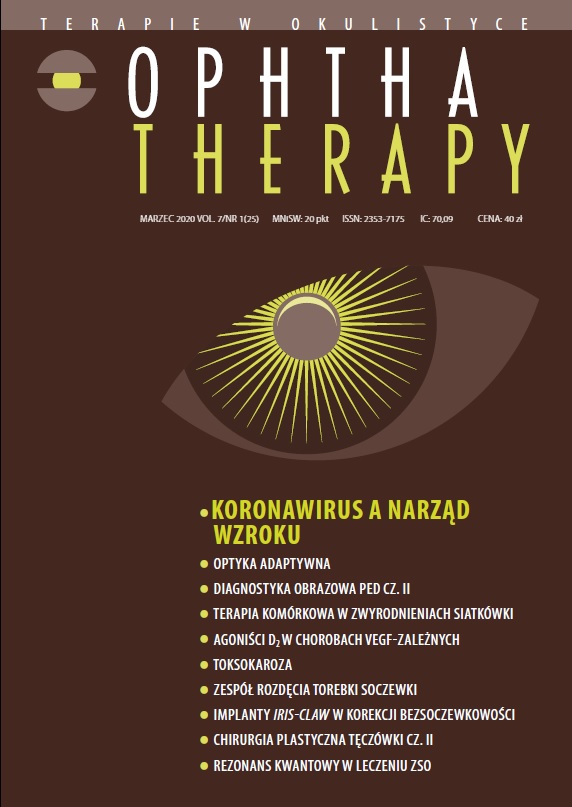Efekty wszczepienia implantów iris-claw do komory tylnej w oczach bezsoczewkowych z niestabilną torebką – retrospektywne badanie obserwacyjne Praca oryginalna
##plugins.themes.bootstrap3.article.main##
Abstrakt
Wprowadzenie: Implantacja soczewek iris-claw jest często stosowaną metodą korekcji bezsoczewkowości z niestabilną torebką. Celem badania była ocena wyników anatomicznych, funkcjonalnych oraz powikłań po zabiegu u pacjentów z afakią i niestabilną torebką soczewki.
Materiał i metody: Do badania włączono 44 oczu (44 pacjentów). Średni wiek: 72,5 ± 20,5 lat (18-95 lat). Średni czas obserwacji: 12,11 + 6,02 miesiąca (od 1 do 24 miesięcy). W 5 oczach (11,36%) wykonano pierwotne wszczepienie implantu, w 24 oczach (54,55%) wymianę implantu tylnokomorowego na soczewkę typu iris-claw, w 15 oczach wtórne wszczepienie implantu.
Wyniki: Końcowa najlepiej skorygowana ostrość wzroku była istotnie statystycznie lepsza niż przed zabiegiem (0,49 ± 0,33 vs 0,36 ± 0,26 wg Snellena), (P<0,05). W 40 oczach (90,91%) błąd refrakcji na koniec okresu obserwacji był w granicach ± 2 Dsph. Istotne powikłania pooperacyjne obejmowały: zapalenie tęczówki 2 oczu (4,55%), przemieszczenie implantu 2 oczu (4,55%), torbielowaty obrzęk plamki 6 oczu (13,64%), odwarstwienie siatkówki 2 oczu (4,55%), wylew krwi do ciała szklistego 1 oko (2,27%), zakrzep żyły środkowej siatkówki 1 oko (2,27%), zapalenie troficzne rogówki 1 oko (2,27%).
Wnioski: Tylnokomorowe implanty wewnątrzgałkowe typu iris-claw mogą być stosowane w oczach z niestabilnym aparatem więzadłowym w szerokim zakresie wskazań operacyjnych, zapewniając dobry efekt anatomiczny i poprawę funkcji.
Pobrania
##plugins.themes.bootstrap3.article.details##

Utwór dostępny jest na licencji Creative Commons Uznanie autorstwa – Użycie niekomercyjne – Bez utworów zależnych 4.0 Międzynarodowe.
Copyright: © Medical Education sp. z o.o. License allowing third parties to copy and redistribute the material in any medium or format and to remix, transform, and build upon the material, provided the original work is properly cited and states its license.
Address reprint requests to: Medical Education, Marcin Kuźma (marcin.kuzma@mededu.pl)
Bibliografia
2. Jezierski M, Kaczmarek I, Prost ME. Zastosowanie implantów soczewek wewnątrzgałkowych typu iris-claw u pacjentów z bezsoczewkowością. OphthaTherapy. 2014; 4(4): 1-5.
3. Toro MD, Longo A, Avitabile T et al. Five-year follow-up of secondary iris-claw intraocular lens implantation for the treatment of aphakia: Anterior chamber versus retropupillary implantation. PLoS ONE 2019; 14(4): e0214140.
4. Stem MS, Todorich B, Woodward MA et al. Scleral-Fixated Intraocular Lenses: Past and Present. J Vitreoretin Dis. 2017; 1(2): 144-52.
5. Walia S, Kashyap S, Bhaisare V et al. Novel technique of sutureless glueless scleral fixated intraocular lens (SFIOL). Indian J Ophthalmol. 2019; 67(1): 64-8.
6. Can E. Flapless and sutureless intrascleral fixation of posterior chamber intraocular lens for correction of aphakia. J Cataract Refract Surg. 2018; 44(8): 929-31.
7. Dinc E, Vatansever M, Dursun Ö et al. Scleral fixated intraocular lens implantation with a modified Z-suture technique. Int Ophthalmol. 2018; 38(6): 2357-61.
8. Saleh M, Heitz A, Bourcier T et al. Sutureless intrascleral intraocular lens implantation after ocular trauma. J Cataract Refract Surg. 2013; 39(1): 81-6.
9. Wallmann AC, Monson BK, Adelberg DA. Transscleral fixation of a foldable posterior chamber intraocular lens. J Cart Refract Surg. 2015; 41(9): 1804-9.
10. Obeng FK, Vig VK, Singh P et al. Posterior Chamber Scleral Fixation of Intraocular Lenses in Post-Vitrectomised Aphakic Eyes. J Clin Diagn Res. 2017; 11(3): NC09-13.
11. Yang C, Chao Y. Long-term outcome of combined vitrectomy and transscleral suture fixation of posterior chamber intraocular lenses in the management of posteriorly dislocated lenses. J Chin Med Assoc. 2016; 79(8): 450-5.
12. Jayamadhury G, Potti S, Kumar KV et al. Retropupillary fixation of iris-claw lens in visual rehabilitation of aphakic eyes. Indian J Ophthalmol. Indian J Ophthalmol. 2016; 64(10): 743-6.
13. De Silva SR, Arun K, Anandan M et al. Iris-claw intraocular lenses to correct aphakia in the absence of capsule support. J Cataract Refract Surg. 2011; 37(9): 1667-72.
14. Rüfer F, Saeger M, Nölle B et al. Implantation of retropupillar iris claw lenses with and without combined penetrating keratoplasty. Graefes Arch Clin Exp Ophthalmol. 2009; 247(4): 457-62.
15. Schallenberg M, Dekowski D, Hahn A et al. Aphakia correction with retropupillary fixated iris-claw lens (Artisan) – long-term results. Clin Ophthalmol. 2014; 8: 137-41.
16. Mohr A, Hengerer F, Eckardt C. Retropupillary fixation of the iris claw lens in aphakia. 1 year outcome of a new implantation techniques. Ophthalmologe. 2002; 99(7): 580-3.
17. Jing W, Guanlu L, Qianyin Z et al. Iris-Claw Intraocular Lens and Scleral-Fixated Posterior Chamber Intraocular Lens Implantations in Correcting Aphakia: A Meta-Analysis. Invest Ophthalmol Vis Sci. 2017; 58(9): 3530-6.
18. Teng H, Zhang H. Comparison of Artisan iris-claw intraocular lens implantation and posterior chamber intraocular lens sulcus fixation for aphakic eyes. Int J Ophthalmol. 2014; 7(2): 283-7.
19. Hara S, Borkenstein AF, Ehmer A et al. Retropupillary fixation of iris-claw intraocular lens versus transscleral suturing fixation for aphakic eyes without capsular support. J Refract Surg. 2011; 27(10): 729-35.
20. Gonnermann J, Klamann MK, Maier AK et al. Visual outcome and complications after posterior iris-claw aphakic intraocular lens implantation. J Cataract Refract Surg. 2012; 38(12): 2139-43.
21. Baykara M, Ozcetin H, Yilmaz S et al. Posterior iris fixation of the iris-claw intraocular lens implantation through a scleral tunnel incision. Am J Ophthalmol. 2007; 144(4): 586-91.
22. Gicquel JJ, Guigou S, Bejjani RA et al. Ultrasound biomicroscopy study of the Verisyse aphakic intraocular lens combined with penetrating keratoplasty in pseudophakic bullous keratopathy. J Cataract Refract Surg. 2007; 33(3): 455-64.
23. Mora P, Calzetti G, Favilla S et al. Comparative Analysis of the Safety and Functional Outcomes of Anterior versus Retropupillary Iris-Claw IOL Fixation. J Ophthalmol. 2018; 2018: 8463569.
24. Schmidt I, Langenbucher A, Moussa S et al. Retroiridale Implantation einer VerisyseTM IrisklauenlinseRetroiridal implantation of a VerisyseTM iris claw lens. Der Ophthalmol. 2014; 112(3): 261-5.
25. Gonnermann J, Amiri S, Klamann M et al. Endothelial cell loss after retropupillary iris-claw intraocular lens implantation. Klin Monbl Augenheilkd. 2014; 231(8): 784-7.
26. Wolter-Roessler M, Küchle M. Correction of aphakia with retroiridally fixated IOL. Klin Monbl Augenheilkd. 2008; 225(12): 1041-4.
27. Forlini M, Soliman W, Bratu A et al. Long-term follow-up of retropupillary iris-claw Intraocular lens implantation: a retrospective analysis. BMC Ophthalmol. 2015; 15: 143.
28. Dick HB, Budo C, Malecaze F et al. Foldable Artiflex phakic intraocular lens for the correction of myopia: two-year follow-up results of a prospective European multicenter study. Ophthalmology. 2009; 116(4): 671-7.
29. Jayamadhury G, Potti S, Kumar KV et al. Retropupillary fixation of iris-claw lens in visual rehabilitation of aphakic eyes. Indian J Ophthalmol. 2016; 64(10): 743-6.

